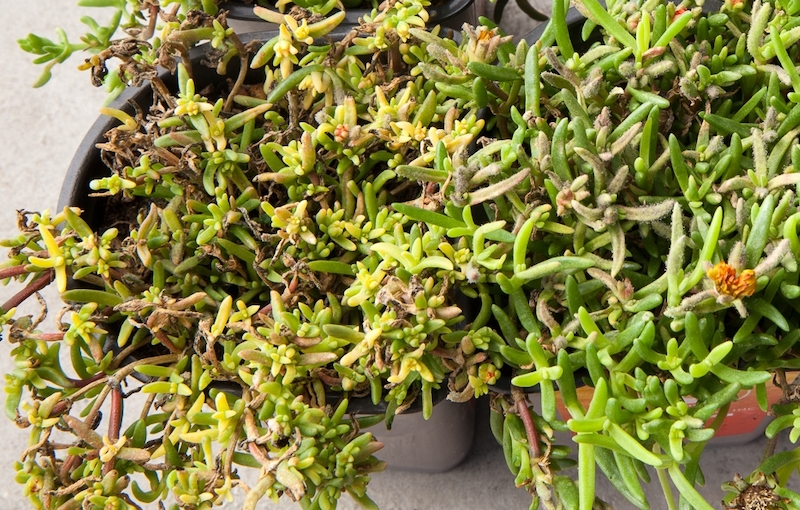Ice plants are low-maintenance perennials that mostly thrive on neglect. Delosperma is not prone to many diseases, but downy mildew, leaf spot, and rust are common problems. Early detection and prevention are essential to keeping ice plants healthy and thriving.

Image courtesy of Steve Tjosvold, UC Cooperative Extension. Photo has been modified.
Ice Plant Downy Mildew
Downy mildew is caused by a fungus that penetrates the leaves. The infection often appears on the bottom of leaves but can impact both sides of the foliage. Downy mildew spreads by spores, and an entire plant and neighboring plants can quickly become infected. Downy mildew will kill individual leaves and possibly the entire plant when left untreated.
Identifying Downy Mildew
Older leaves are more susceptible to downy mildew. Light green to yellow spots are signs of the disease, and the spots later turn brown and kill that part of the leaf.

Photo courtesy of Steve Tjosvold, UC Cooperative Extension
Treating Downy Mildew
Treat downy mildew on ice plants by removing and destroying infected leaves. This disease can quickly spread, so isolating the infection to contain the spores is essential. Spray an infected plant with a fungicide to treat downy mildew on ice plants. Divide plants in the fall or spring and remove debris and dead growth to increase air circulation and reduce the risk of downy mildew.
Ice Plant Leaf Spot
Leaf spot is a plant disease that bacteria or fungi can cause. Overgrown plants in damp, humid conditions are more susceptible to leaf spots.
Identifying Leaf Spot
Infected leaves have small, circular spots. The spots are often yellow or white, and the damage radiates from the initial infected area. The spots will turn brown and kill the infected plant tissue. With time, leaf spots can infect an entire plant and be fatal.
Treating Leaf Spot
Treat leaf spots on ice plants by removing infected leaves at the first sign of an infection. Destroy the damaged foliage to contain the disease and prevent a bigger infection. Spray the plant with a fungicide for several weeks after the infection breaks out to save the ice plant from a widespread infection.
Ice Plant Rust
Rust is a fast-moving fungal disease that impacts ice plants' stems, foliage, and flowers. Like most fungal infections, rust is more likely to occur in damp, crowded conditions.
Identifying Rust
The infection appears as yellow or orange spots on the top or bottom of the leaves. The spots will grow larger with time, and the entire leaf will turn brown and die when the infection overtakes the plant.
Treating Rust
The most effective way to treat rust is to trim away infected parts of the plant. Removing the damage will keep the infection small and under control. Spray the plant with a fungicide to prevent rust disease from spreading. Treat rust by pruning leggy plants and removing mulch to allow more air to circulate. Divide overgrown ice plants to prevent future outbreaks of rust.
Ice Plant Disease Chart
|
Disease |
Identifying |
Treating |
|
Downy Mildew |
Light green or yellow spots |
Prune & discard stems |
|
Leaf Spots |
Dark spots on leaves |
Fungicides & air circulation |
|
Rust |
Yellow or orange spots |
Fungicides & air circulation |
Sources: "Reporting downy mildew of ice plants in California." Agriculture and Natural Resources, University of California. ucanr.edu
 |
Author Alison Cotsonas - Published 06-05-2023 |
